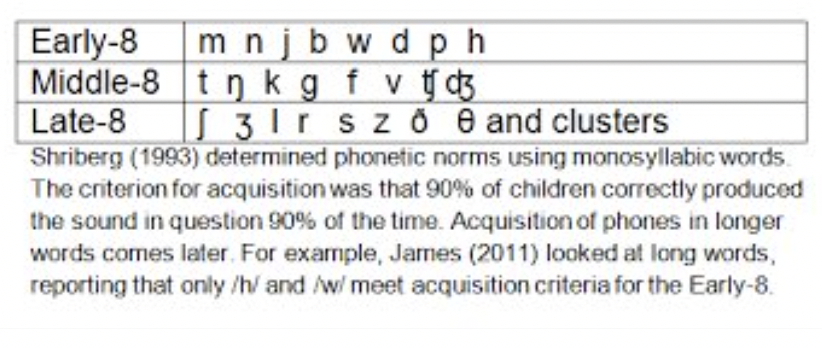Treatment Procedures for Phonetic (Articulation) Disorders
1/9
There's no tags or description
Looks like no tags are added yet.
Name | Mastery | Learn | Test | Matching | Spaced |
|---|
No study sessions yet.
10 Terms
Name some of the traditional approaches to treating phonetic (articulation) disorders
Sensory-Perceptual Training
Production of Sound in Isolation
Nonsense Syllables (IMF)
Words (IMF)
Structured Contexts - Phrases and Sentences
Spontaneous Speech
What are the typical difficulties with artiuclation?
The late 8

What treatment approach relies on clinician modeling?
Van Riper’s (Traditional) Approach
What treatment approach focuses on correction of individual phonemes?
Van Riper’s (Traditional) Approach
What is Van Riper’s (Traditional) Approach
Relies on clinician modeling
Clinician provides models of target sounds and ear training using isolation, stimulation, identification, and discrimination
Focused on correction of individual phonemes
Behavioral modification is commonly used with this approach
Includes reinforcement schedules
What should intervention begin with under Van Riper’s (Traditional) Approach? What is it followed by?
Ear training; this is followed by a sequence of therapy goals
What are the 5 steps in Van Riper’s (Traditional) Articulation Approach?
Sensory-perceptual training
Ear training
Production training
Teach speech sound in isolation– this is step but start with syllable.
Sound Stabilization
Teach speech sound in increasing length and complexity
Word Level
Sentence Level
Conversational Level
Generalization
Child generalizes production into multiple settings and contexts
Maintenance
What is required for auditory training in the van riper (traditional) approach?
Child must be convinced of the problem
The correct sound and the error sound must be isolated
The correct sound and the error sound must come to have individual identities
Child must be stimulated with the correct sound
Child must be provided with repeated opportunities to clear discrimination of the correct and erred sounds
How is production trained under Van Riper’s (Traditional) Approach?
After the client can recognize new sound
Five ways to elicit sound
Auditory Stimulation/Imitation
Use of Context
Moto-Kinesthetic Method
Sound Approximation
Phonetic Placement
How are objects used in the van riper traditional approach?
Child must be convinced of the problem
The correct sound and the error sound must be isolated
The correct sound and the error sound must come to have individual identities
Child must be stimulated with the correct sound
Child must be provided with repeated opportunities to clear discrimination of the correct and erred sounds